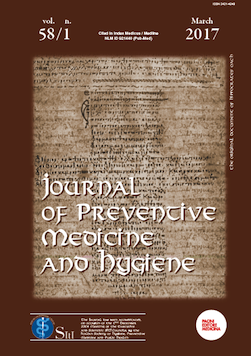Abstract
Aims: The effectiveness of ozone (aqueous and gaseous) treatment as alternative sanitizing technology to common conventional disinfectants for the reduction of the microbial contamination of both water and air was investigated.
Methods: Ozone was added for 20 minutes to a well-defined volume of water and air by the system named “Ozonomatic®”.
The effectiveness of ozonation was determined by counting UFC/m3 or ml of bacteria present in samples of air or water collected before (T0) and after (T1) the addition of ozone and comparing the microbial load of different bacteria present in ozonized and non-ozonized samples.
Results:
When the ozonisation equipment was located at 30 cm from the water level contained in the bath tub in which the bacteria investigated were inoculated, the sanitization was able to reduce by 70.4% the total microbial load present in the aerosol at a temperature of 36°C for 48 hours. Conversely, at 22°C for 5 days a modest decrease (9.1%) was observed. Escherichia coli and Pseudomonas aeruginosa were completely eliminated. A 93.9% reduction was observed for Staphylococcus aureus, followed by Streptococcus faecalis (25.9%).
The addition of ozone to water was able to almost eliminate Staphylococcus aureus (98.9% of reduction), and to exert a strong impact also on Legionella pneumofila, with a 87.5 % of diminishment. Regarding Streptococcus faecalis and Pseudomonas aeruginosa showed a diminishment of 64.2% and 57.4%, respectively. Conversely, only a 26.4% reduction was observed for the bacterium Escherichia coli.
This study showed that the addition of ozone in the air exerted a modest reduction on microbial load at 36°C, whereas no effect was observed at 22°C.
Conclusions:
Aqueous and gaseous ozone treatments were effective against microbial contaminants reducing the CFU of the microorganisms studied. These results confirm the efficacy of the ozone disinfection treatment of both water and air; particularly it represents an extremely promising alternative allowing the possibility to reuse contaminated water.
References
Farooq S, Akhlaque S. Disinfection, sterilization, and preservation. Comparative response of mixed cultures of bacteria and virus to ozonation. Seymour S. Block. Ed. Lea & Febiger.
Sehulster L, Chinn RY. Guidelines for environmental infection control in health-care facilities. Recommendations of CDC and the Healthcare Infection Control Practices Advisory Committee (HICPAC). MMWR Recomm Rep. 2003;52(RR-10):1-42.
Wallace CA. New developments in disinfection and sterilization. Am J Infect Control 2016; 44(5 Suppl):e23-7. doi: 10.1016/j.ajic.2016.02.022.
Farajzadeh D, Qorbanpoor A, Rafati H, Isfeedvajani MS. Reduction of date microbial load with ozone. J Res Med Sci 2013; 18(4):330-4.
Gómez-López VM, Gil MI, Allende A, Vanhee B, Selma MV. Water reconditioning by high power ultrasound combined with residual chemical sanitizers to inactivate foodborne pathogens associated with fresh-cut products. Food Control 2015;-53:29–34. 10.1016/j.foodcont.2014.12.032.
Tirpanalan Ö, Zunabovic M, Domig K, Kneifel W. Mini review: Antimicrobial strategies in the production of fresh-cut lettuce products. In: Méndez-Vilas A., editor. Science against Microbial Pathogens: Communicating Current Research and Technological Advances. Volume 1. Formatex Research Center; Badajoz, Spain: 2011. pp. 176–188.
Hua G, Reckhow DA. Comparison of disinfection byproduct formation from chlorine and alternative disinfectants. Water Research2007; 41(8):1667-78.doi: 10.1016/j.watres.2007.01.032.
Wei X, Chen X, Wang X, Zheng W, Zhang D, Tian D, Jiang S, Ong CN, He G, Qu W. Occurrence of regulated and emerging iodinated DBPs in the Shanghai drinking water. PLoS One 2013;8(3):e59677. doi: 10.1371/journal.pone.0059677.
Baur S, Klaiber RG, Koblo A, Carle R. Effect of different washing procedures on phenolic metabolism of shredded, packaged iceberg lettuce during storage. J Agric Food Chem2004; 52(23):7017-25. doi: 10.1021/jf048961a.
Selma MV, Beltrán D, Allende A, Chacón-Vera E, Gil MI.Elimination by ozone of Shigella sonnei in shredded lettuce and water. Food Microbiol 2007; 24(5):492-9. doi: 10.1016/j.fm.2006.09.005.
Sapers G.M. Efficacy of washing and sanitizing methods for disinfection of fresh fruit and vegetable products. Food Technol Biotechnol 2001; 39(4):305–311.
Banach JL, Sampers I, Van Haute S, van der Fels-Klerx HJ.Effect of Disinfectants on Preventing the Cross-Contamination of Pathogens in Fresh Produce Washing Water. Int J Environ Res Public Health 2015; 12: 8658-8677. doi: :10.3390/ijerph120808658.
Ngwenya N, Ncube EJ, Parsons J. Recent advances in drinking water disinfection: successes and challenges. Rev Environ Contam Toxicol 2013; 222:111-70. doi: 10.1007/978-1-4614-4717-7_4.
Rosenblum J, Ge C, Bohrerova Z, Yousef A, Lee J.Ozonation as a clean technology for fresh produce industry and environment: sanitizer efficiency and wastewater quality. J Appl Microbiol. 2012; 113(4):837-45. doi: 10.1111/j.1365-2672.2012.05393.x.
Nagai T, Sobajima H, Iwasa M, Tsuzuki T, Kura F, Amemura-Maekawa J, Watanabe H.Neonatal sudden death due to Legionella pneumonia associated with water birth in a domestic spa bath. J Clin Microbiol 2003; 41(5): 2227-9. doi: 10.1128/JCM.41.5.2227–2229.2003.
Ohno A, Kato N, Yamada K, Yamaguchi K.Factors influencing survival of Legionella pneumophila serotype 1 in hot spring water and tap water. Appl Environ Microbiol 2003; 69: 2540-7. doi: 10.1128/AEM.69.5.2540–2547.2003.
Roig J, Sabria M, Pedro-Botet M-L. Legionella spp.: community acquired and nosocomial infections. Curr Opin Infect Dis 2003; 16(2):145-51. doi: 10.1097/01.aco.0000065081.06965.cf.
César J, Sumita TC, Junqueira JC, Jorge AO, do Rego MA.Antimicrobial effects of ozonated water on the sanitization of dental instruments contaminated with E. coli, S. aureus, C. albicans, or the spores of B. atrophaeus. J Infect Public Health 2012; 5(4):269-74. doi: 10.1016/j.jiph.2011.12.007.
Heß S, Gallert C. Sensitivity of antibiotic resistant and antibiotic susceptible Escherichia coli, Enterococcus and Staphylococcus strains against ozone. J Water Health 2015; 13:1020-8. doi: 10.2166/wh.2015.291.
Aguayo E, Escalona V, Silveira AC, Artés F. Quality of tomato slices disinfected with ozonated water. Food Sci Technol Int 2014; 20(3):227-35. doi: 10.1177/1082013213482846.
Horvitz S, Cantalejo MJ. Application of ozone for the postharvest treatment of fruits and vegetables. Crit Rev Food Sci Nutr 2014; 54(3):312-39. doi: 10.1080/10408398.2011.584353.

